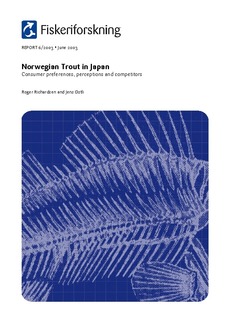| dc.description.abstract | Consumer preferences on 7 product products of salmon and trout were evaluated using blind tests in 2 (two) different product categories: Smoked and Sashimi. This preference test was conducted as a Central Location Test in Tokyo and Osaka. 240 married women were recruited as participants evenly distributed in age groups between 30 to 60 years of age. Product testing was also done by a Japanese expert sensory panel.
In the product category of smoked, Japanese consumers ranked the Norwegian trout as the best! Smoked products based on frozen Norwegian trout were ranked on top, followed by smoked from fresh Norwegian trout. Frozen Atlantic salmon, both of Norwegian and Chilean origin, together with frozen Chilean trout were evaluated as the second best group. The poorest ranking in the smoked category was given to products made from fresh Tasmanian salmon and fresh Atlantic salmon.
The Norwegian trout scored high on good (natural) red colour, firm texture of the flesh, distinct fishy flavour, a high fat content, including good (fat) marbling, i.e. white stripes in the meat.
Rather surprisingly, Norwegian trout for use as sashimi also achieved a good score with the consumers. From what we could expect, fresh Norwegian salmon and fresh Tasmanian salmon were also evaluated well by the consumers. Tasmanian salmon in particular scored much better for use as sashimi than as a smoked product. Conversely, we see that frozen Chilean salmon came out significantly poorer than the six remaining products tested.
Preference Mapping indicates that a high fat content, “oily” aftertaste, “sweetness”, “melting texture”/elastic texture, and distinct/visible white stripes (marbling) “can explain” why some products were evaluated more attractive than others. | |
